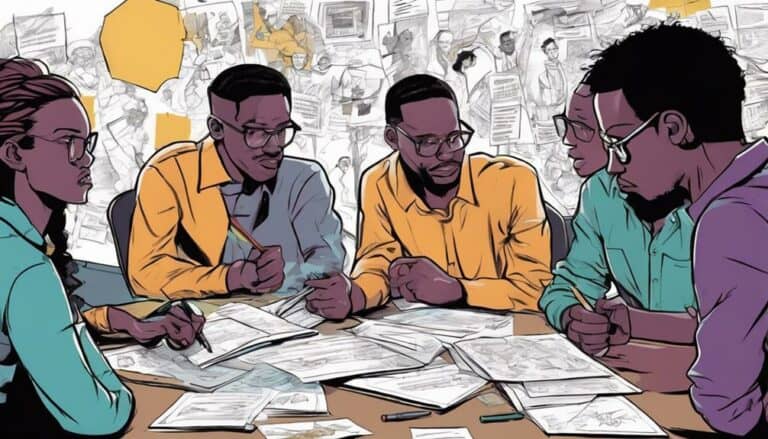To enhance problem recognition, focus on attitude and mindset by fostering solution-driven thinking. Activate analytical skills for root cause identification and employ creativity in problem-solving. Encourage active team participation for diverse insights and utilize structured brainstorming techniques. Embrace innovation by creating a dynamic environment for unconventional ideas. Strengthen communication through transparent practices and collaboration tools. This structured training builds a strong foundation for effective problem-solving techniques that can help individuals and teams excel.
Key Takeaways
- Foster a solution-oriented attitude and proactive mindset.
- Develop growth mindset for effective problem recognition.
- Utilize active listening and analytical thinking for insights.
- Encourage group brainstorming and structured idea generation.
- Create a dynamic environment for innovation and conflict management.
Attitude and Mindset Training
How can attitude and mindset training enhance problem recognition skills in individuals and teams?
Attitude and mindset training play an essential role in developing effective problem recognition skills. By focusing on fostering a solution-oriented attitude, individuals are equipped with the resilience, adaptability, and flexibility needed to tackle challenges. This training instills a proactive and constructive mindset, enabling individuals to approach problems with confidence and determination.
Emphasizing skills training, attitude training helps individuals view obstacles as opportunities for growth rather than barriers to success. By developing a growth mindset, individuals and teams can enhance their ability to recognize problems early on and address them efficiently.
Through attitude and mindset training, individuals are better prepared to navigate complex situations, think critically, and find innovative solutions to various challenges they encounter. This proactive approach to problem recognition sets the foundation for effective problem-solving techniques and overall success in both personal and professional endeavors.
Individual Problem-Solving Techniques
Developing proficiency in individual problem-solving techniques requires a combination of active listening, analytical thinking, creativity, effective communication, and decision-making skills. Active listening is key to gathering valuable information and insights essential for problem-solving.
Analytical thinking is essential for researching, understanding root causes, and evaluating potential solutions. Creativity plays a significant role in balancing logical reasoning with innovative ideas to effectively identify and address problems.
Effective communication skills are necessary to articulate thoughts, ideas, and solutions clearly to stakeholders involved in the process. Decision-making skills are integral at every stage of individual problem-solving, guiding the process towards successful outcomes.
Group Brainstorming Strategies
Group brainstorming strategies foster collaborative idea generation and diverse perspectives to enhance problem-solving efficiency and creativity within teams. When implementing group brainstorming techniques, consider the following:
- Encouraging Active Participation: Guarantee all team members actively contribute ideas during brainstorming sessions to maximize the variety of solutions generated.
- Utilizing Brainstorming Tools: Incorporate tools like virtual whiteboards or collaborative platforms to facilitate seamless idea sharing and organization, especially in remote team settings.
- Implementing Structured Techniques: Experiment with methods such as mind mapping or round-robin brainstorming to stimulate creativity and encourage the exploration of different problem-solving avenues.
Encouraging Innovation and Conflict
Encouraging innovation and embracing conflict within a team setting fosters a dynamic environment that nurtures creativity and critical thinking. By creating a safe space for unconventional ideas and out-of-the-box thinking, teams can explore unconventional ideas and perspectives that may lead to breakthrough solutions.
Conflict, when managed effectively, can challenge assumptions and encourage critical thinking, pushing individuals to contemplate unconventional ideas that they mightn't have otherwise. Diverse opinions are essential in fostering innovation; welcoming and constructively debating these opinions can lead to effective problem recognition and unique solutions.
Conflict resolution within the team dynamics can improve communication and trust, ultimately enhancing the overall collaborative process. Embracing conflict as a natural part of the problem-solving process can pave the way for innovative thinking and encourage the generation of unconventional yet effective solutions.
Transparent Communication Practices
Transparent communication practices are essential in fostering a cohesive and productive team environment, enabling effective information sharing and collaboration. When it comes to implementing these practices, consider the following:
- Embrace Open Communication: Encouraging progress sharing and challenges sharing within your team can lead to a deeper understanding of each other's work and foster a culture of trust and support.
- Utilize Collaboration Tools: Leveraging tools like Wrike can streamline tasks, facilitate drafts sharing, and assist in timeline monitoring, ensuring that everyone is aligned and working towards common goals.
- Enhance Problem Recognition and Resolution: By maintaining transparent communication channels, teams can more effectively identify and address issues, leading to quicker problem resolution and improved overall performance.
Incorporating these strategies into your team's workflow can significantly boost team collaboration and productivity, ultimately leading to more successful outcomes in problem recognition and resolution.
Conclusion
By implementing attitude and mindset training, individual problem-solving techniques, group brainstorming strategies, encouraging innovation and conflict, and transparent communication practices, individuals and teams can be effectively trained in problem recognition techniques.
Through a combination of these strategies, you can create a dynamic and innovative team that's able to recognize and tackle challenges head-on, leading to increased productivity and success.
Embrace these techniques and watch as your team transforms into problem-solving powerhouses.

